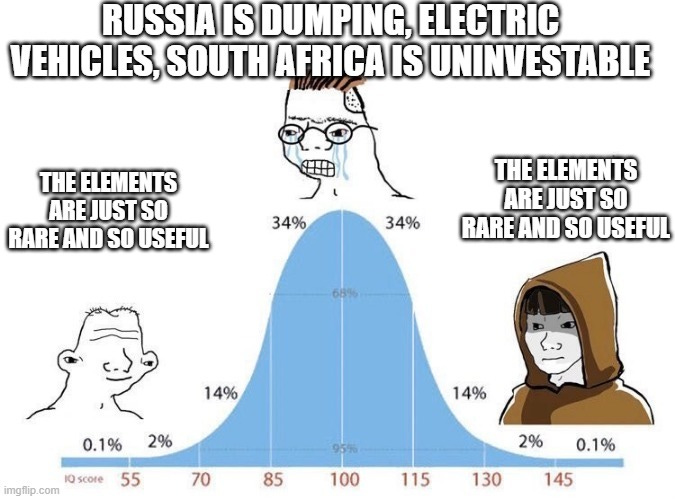Another Mud Pumper: Sylvania Platinum $SLP.L $SLP; Elegy for Stillwater, Catharsis for Sibanye $SBSW
The Least Degenerate Platinum Exposure
Once again the market has taken Sibanye Stillwater (SBSW) out to the woodshed, and I am reminded of the AI poetry with which I started my first writeup on SBSW; “I love Sibanye Stillwater, and Thus I Hate Myself.” I think I knew that the bottom wasn’t in yet when I started the article in this way, and I am not a skilled enough trader to catch the bottom, so instead I catch the falling knife.
Why I love Sibanye Stillwater $SBSW, and thus I hate myself.
Hey ChatGPT, dunk on Sibanye Stillwater (SBSW) in the style of “A Lover’s Complaint” by Sir Thomas Wyatt.
All self deprecating humor aside, the best take on platinum group metals (PGMs) came from one of the many earnings calls I have listened to across the industry. I can’t even remember the company or the executive, but when asked about long term demand for PGMs, his response was, these elements are just so rare and so useful, there will be a market for them. I think that is the essence of the situation, even if it fits on the IQ distribution meme. Apologies for the excessive meme use, I need the catharsis when I look at my SBSW cost basis.
I am comforted in my SBSW position by their gold exposure, SBSW recently raised $101 million by pre-selling about 52,000 ounces between now and 2026. Their annual production is between 600,000 and 800,000 ounces, so this represents a pre selling of about 4.5% of their gold production for the next two years. SBSW’s stated desire was to raise $500 million this way, but by the price achieved it appears that the market is a bit soft at the moment. If you subtract the market value of Sibanye’s 50% ownership of DRDGOLD (DRD), you get the exact same market capitalization as Equinox Gold (EQX), which implies the market price of SBSW is valuing all of their platinum assets at zero. I would take the over on that bet.
As a quick refresher on the PGMs thesis, the vast majority of PGMs are used in catalytic converters for internal combustion vehicles and hybrid vehicles. Hybrid vehicles even require 15% more PGMs than pure internal combustion vehicles, and as air quality is an enormous concern in densely populated countries, corners won’t be cut on legal requirements for catalytic converters. While automobile sales globally are suppressed due to the sudden increase in interest rates, on the next boom cycle, there is likely to be a PGM deficit and an increase in prices. Almost 80% of PGMs are mined in South Africa and neighboring Zimbabwe, so that jurisdictional risk is hard to avoid.
If you don’t have the same risk enthusiasm as I do, I have discovered a potentially more stable way of getting exposure to platinum group metals. On my recent writeup on DRD, I was fond of the business model, but I didn’t prefer DRD over my EQX. I did learn, however, that there is another mud pumper, that’s how tailings treatment specialists refer to themselves, but with a focus on extracting PGMs instead of gold.
Special thanks to subscriber
for asking me to look into Sylvania Platinum (SLP). Honorable mentions to those subscribers who asked me to look into platinum group metals exploration companies. Even though I call myself a degen, I don’t find the lottery-ticket nature of exploration companies attractive. I do acknowledge a few of my picks have blown up on me this year, but I don’t go looking for companies that have a big chance of blowing up.Sylvania Platinum is a South African tailings dump processing company that produces about 75,000 ounces of PGMs annually, at an all-in-sustaining-cost (AISC) of between $700 and $900 an ounce. That AISC is even lower than Anglo American, the low cost producer at scale, and is remarkably even lower than the current prices of platinum and palladium which are in the toilet. So for those of you who want exposure to the PGMs thesis, and are willing to give up some torque in favor of a company that is currently profitable and focuses on returning capital to shareholders through dividends, Sylvania Platinum is probably the best choice for you.
There is a growth project on the horizon, a joint venture which for the first time would allow SLP to profit off of the chromium in the tailings, and is projected to come online in the first half of 2025. Currently at all other tailings dumps, the chromium is returned to the miner. The Thaba JV is projected to get annual production up from 75,000 ounces to 85,000 ounces for 2026.
Sylvania’s capital allocation policy is to pay minimum dividends of 40% of free cash flow. In addition to that, there have been small share buyback programs announced occasionally. As a South African company, they pay dividends every half year instead of quarterly. I wouldn’t expect much in the way of dividends while platinum group metals prices are low, but at any mean reversion toward 2021 platinum and palladium prices, SLP has the capability of earning their market capitalization in profits in two years.
On my article comparing the prices of the three major platinum miners, I had calculated the market capitalization per annual ounce of PGMs production. For Sylvania, you are buying 2026 annual production for $2,262 an ounce. Today, Anglo American is $2,741, Impala Platinum is $1,452, and after putting Stillwater on care and maintenance, Sibanye is $1,415. But AISC is between $700 and $900 for SLP, while it is $1,050 for Anglo, $1,150 for Impala, and $1,250 for Sibanye. This makes Sylvania the best in class for quality, and surprisingly, with the shutdown of Stillwater, Sibanye and Impala are tied for torque to PGM prices.
The CEO Jaco Prinsloo was promoted from within the company in 2020, and prior to Sylvania he was the chief metallurgist for Anglo American. There are a few insider buys, including from the newly appointed chairman of the board, but otherwise, there is no obvious strong capitalist to align incentives and monitor bad behavior. There are no red flags from management indicating unreasonable agency conflicts.
Sylvania has essentially no debt, and while not quite a Benjamin Graham net-net, they do have $110 million in cash compared to their $192 million market capitalization.
Sylvania Platinum, aside from the same jurisdiction risk that most platinum group companies have through South Africa, is probably the least degenerate pure PGM company available to retail investors. As an additional bonus for paid subscribers, anything that I discover which is particularly interesting gets put behind the paywall.
Keep reading with a 7-day free trial
Subscribe to Value Degen’s Substack to keep reading this post and get 7 days of free access to the full post archives.








